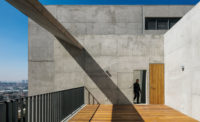São Paulo Begins Implementation of New City Plan

Photo © Nelson Almeida
São Paulo’s new city plan aims to increase urban density along major transportation corridors and to alleviate traffic congestion by encouraging the city’s 12 million residents to utilize public transportation.
After decades spent in thrall to the car, which brought it epic traffic jams across an ever-expanding urban sprawl, the Brazilian city of São Paulo has finally decided to try something different.
 |
|
Image courtesy Prefeitura de São Paulo
The plan calls for an overhaul of the city's building code in order to accomodate taller mixed-use buildings.
|
Fernando Haddad, the mayor of this metropolis of nearly 12 million people, is undertaking sweeping reform of the city’s approach to planning with the goal of increasing urban density along metro,train, and bus corridors. This objective is at the heart of São Paulo’s most radical strategic master plan in decades, with a bold prioritization of public over private transport in the citadel of Brazil’s powerful motor industry.
Passed by the city’s municipal assembly last year, Haddad’s “Plano Diretor” is being implemented in a series of changes to planning laws to give legal form to the city’s new direction.
“We are establishing a long-term plan that the city has not had since Prestes Maia [mayor during World War II], who had a ‘freeway’ conception of the city,” Haddad points out in an interview with RECORD. “We have never had such a modernizing vision of the city as we have now.”
At a recent conference in São Paulo organized by the Brazilian Association of Architectural Practices (AsBEA), there was enthusiasm for the possibilities opening up, thanks to the new direction.
Codes for building along public-transport corridors are being altered to allow for taller buildings and smaller unit sizes. To encourage the use of public transport, codes that demanded a minimum number of parking spaces in buildings are being rewritten to include a cap. To try and cut Paulistanos deep-seated car dependency (even for humble tasks like picking up a carton of milk), the long-lamented, decades-old law that banned mixed-use occupancy is being relaxed in regions earmarked for densification, meaning buildings can once again have ground-floor commercial spaces with residents above.
But among some conference participants, doubts were raised. The city’s main business association has warned that, in light of Brazil’s ongoing recession, developers might struggle to find buyers for a flood of new commercial spaces. Meanwhile, SECOVI, the main lobby group of the city’s real-estate sector, has warned that smaller housing units with limited parking space might be a tough sell to the city’s middle class, the main impetus of the local housing market.
So great is São Paulo’s car addiction that some of the mayor’s most visible initial changes have run into stiff resistance among a significant portion of the city’s population. Already Haddad’s administration has put nearly 250 miles of new bus corridors in place and is on the way to a similarly sized network of bike lanes. Creating the space for these has squeezed the car fleet on what were already heavily congested streets, further irritating commuters.
Some experts have warned that there is a disconnect in the plan between more intensive use of land and transport infrastructure. “The new plan will increase density without adequate transport planning. The obvious solution is more metro lines rather than bus corridors, but the state government struggles to deliver these to the city. This risks even greater congestion in the future,” warns Cândido Malta Campos Filho, the city’s former planning secretary and professor emeritus of the architecture and urbanism faculty at the University of São Paulo (USP-FAU).
But Fernando de Mello Franco, the city’s secretary for urban development, says “triggers” are in place to avoid this happening. “If the expected investment in public transport along a corridor does not take place, then permission to build will not be granted,” he says.
Implementation of the plan via changes to the city’s planning codes is currently under way. Its critics have accused city hall of mismanaging the process, sowing confusion.
But most of the city’s urbanists have broadly welcomed the new outlook. Says Alexandre Delijaicov, professor at USP-FAU, “Despite its contradictions, this plan is a great step forward.”




